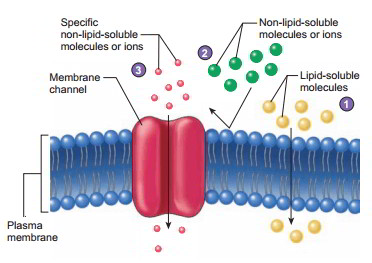The plasma membrane is both a barrier and entrance in between the cytoplasm and ECF. It is selectively permeable– it permits some things through, such as nutrients and wastes, however generally avoids other things, such as proteins and phosphates, from going into or leaving the cell.
The techniques of moving substances through the membrane can be categorised in 2 overlapping methods: as passive or active mechanisms and as carrier-mediated or not. Passive mechanisms need no energy (ATP) expense by the cell. For the most parts, the random molecular movement of the particles themselves supplies the required energy Passive mechanisms consist of purification, diffusion, and osmosis. Active mechanisms, nevertheless, take in ATP. These consist of active transport and vesicular transport Carrier-mediated mechanisms utilise a membrane protein to transport substances from one side of the membrane to the other.
Methods of Membrane Transport
| Transport Without Carriers | Movement of material without the help of carrier proteins |
| Filtration | Movement of water and solutes through a selectively permeable membrane as a result of hydrostatic pressure |
| Easy diffusion | Diffusion of particles through water or air or through a living or artificial membrane, down their concentration gradient, without the help of membrane carriers |
| Osmosis | Net circulation of water through a selectively permeable membrane, owned by either a distinction in solute concentration or a mechanical force |
| Carrier-Mediated Transport | Movement of product through a cell membrane with the help of carrier proteins |
| Facilitated diffusion | Transport of particles through a selectively permeable membrane, down their concentration gradient, by a carrier that does not straight take in ATP |
| Active transport | Transport of particles through a selectively permeable membrane, up their concentration gradient, with the help of a carrier that takes in ATP |
| Primary active transport | Direct transport of solute particles by an ATP-using membrane pump |
| Secondary active transport | Transport of solute particles by a carrier that does not in itself utilize ATP however depends upon concentration gradients produced by main active transport |
| Cotransport | Transport of 2 or more solutes at the same time in the very same instructions through a membrane by either facilitated diffusion or active transport |
| Counter-transport | Transport of 2 or more various solutes in opposite instructions through a membrane by either facilitated diffusion or active transport |
| Uniport | A carrier that transfers just one solute, utilizing either facilitated diffusion or active transport |
| Symport | A carrier that carries out cotransport |
| Antiport | A carrier that carries out counter transport |
| Vesicular (Bulk) Transport | Movement of fluid and particles through a plasma membrane by method of membrane vesicles; takes in ATP |
| Endocytosis | Vesicular transport of particles into a cell |
| Phagocytosis | Process of swallowing up big particles by methods of pseudopods; “cell consuming” |
| Pinocytosis | Process of imbibing extracellular fluid where the plasma membrane sinks in and pinches off little vesicles including beads of fluid |
| Receptor-mediated endocytosis | Phagocytosis or pinocytosis where particular solute particles bind to receptors on the plasma membrane, and are then taken into the cell in clathrin-coated vesicles with a very little quantity of extraneous matter |
| Exocytosis | Process of getting rid of material from a cell by methods of a vesicle approaching the cell surface, merging with the plasma membrane, and expelling its contents; utilized to release cell secretions, change damaged plasma membrane, and change membrane that has actually beeninternalisedd by endocytosis |


 (47 votes, average: 4.59 out of 5)
(47 votes, average: 4.59 out of 5)